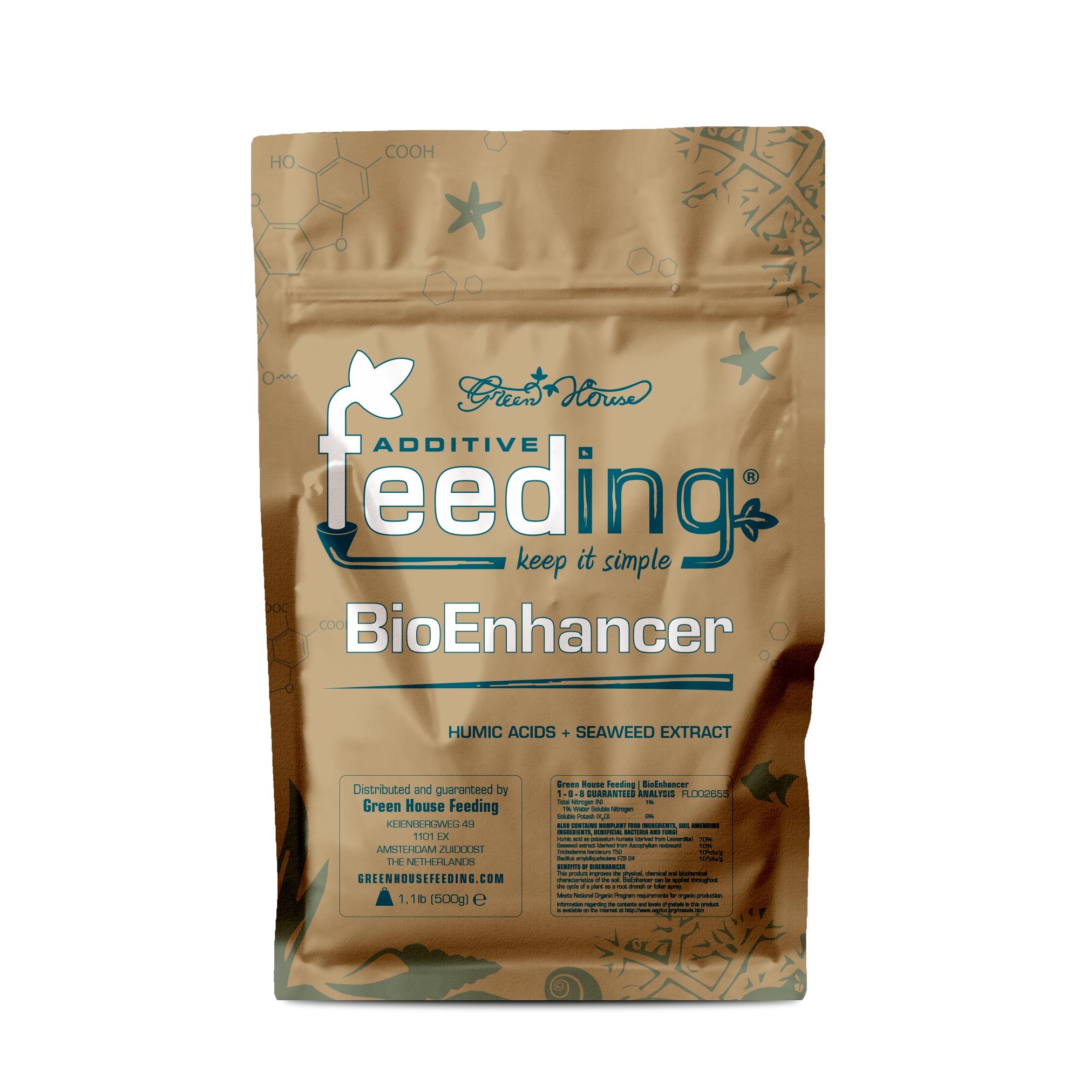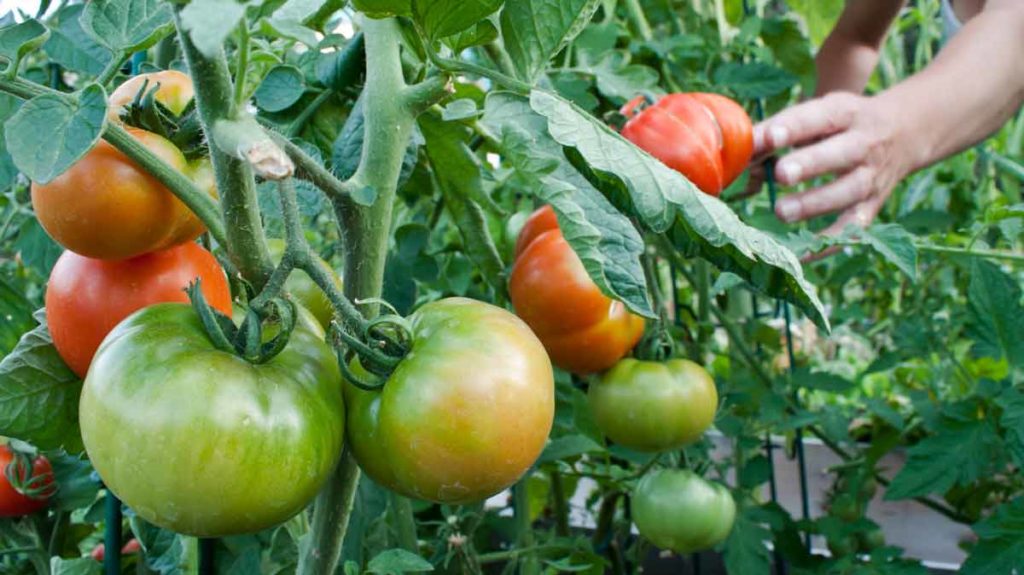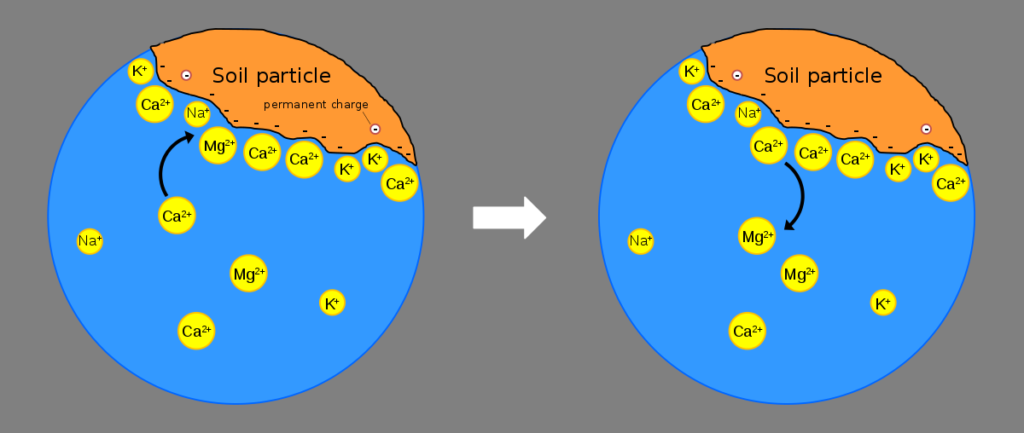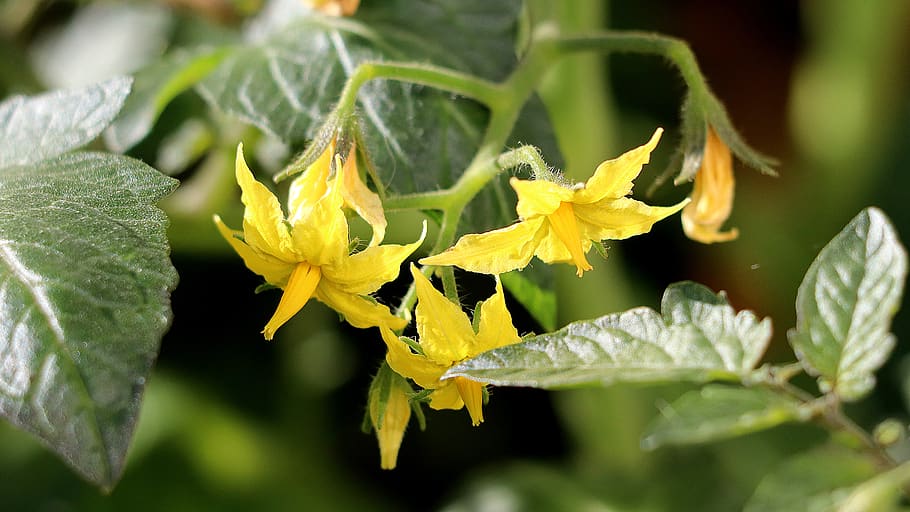You’re in bloom, staring at healthy, green plants and wondering, “Where are all the flowers!?” Does this sound familiar? After all, you gave your plants the best environment, nutrients, and irrigation to treat them better than you treat yourself, but they’re still missing big buds! Sounds like we need to talk about getting you on the best organic bloom booster!
The way bloom boosters ramp up the size and quality of your buds may seem like magic. But it’s not. Rather it’s science!
The good news is that you can understand this science. To help you, we’re going to channel Bill Nye to explain how these products work and why you should add them to your grow.
Let’s go! Big blooms await.

BioEnhancer for the Win
Green House Feeding hit it out of the park with this one. It includes all of the most important big bud boosting additives from only the best sources.
We love that only a little goes a long way to making your buds respond positively, and by that we mean it adds weight.
Certified organic by OMRI and Control Union, so you can rest assured that your customers are getting 100% organic nutrients.
What Nutrients Do Plants Need?
While plants need a variety of nutrients to grow and thrive, these needs change throughout the plants’ lives.
Think of plants like humans. We wouldn’t be happy if we were fed mashed carrots our entire lives! If you apply the same organic nutrient blend during the seedling, vegetative, and flowering stages, you’re not optimizing your plants’ nutrition, and their displeasure will show.
To help your plants perform well throughout their lives, apply liquid or powder nutrients that meet the specific needs of each growth stage. But before you can do that, you need to figure out which nutrients a plant needs when.
Nutrients for Vegetative Growth
When a plant is in its vegetative growth stage, it has one main goal: grow tissue including leaves, stems, and roots. It’s not worried about the flowers we humans are impatiently waiting for.
During this time, cells are rapidly multiplying as a plant grows from a tiny seedling into a large plant. By providing your plant with the necessary nutrients during this phase, you’ll set the framework for a vigorous plant that can support flowers and fruit.
So, what are the necessary nutrients?
Plants require a high dose of nitrogen during the vegetative stage to help them form new cells. You might know that nitrogen is a major component of amino acids, which link together to form larger proteins. But did you know amino acids also form the sites where cells divide? That’s one reason why an adequate amount of nitrogen is essential when plants are rapidly growing. If they don’t have a place to produce new cells, they can’t grow!
Plants also need other nutrients, including potassium and phosphorus, when they are producing leaves, roots, and shoots. However, the necessary quantity is lower than the required amount of nitrogen. That’s why when you look at nutrient blends formulated for vegetative growth, such as Green House Feeding BioGrow, you’ll see a high ratio of nitrogen to potassium and phosphorus. For example, BioGrow has an NPK ratio of 7-2-4.
Along with these macronutrients, it’s important to ensure that your plants receive secondary nutrients and micronutrients. If you overlook these little guys your plants will be in trouble. So, make sure to provide adequate amounts of calcium, sulfur, and magnesium during the vegetative stage.
The Power of Secondary Nutrients
Calcium is crucial for holding together cell walls and cell membranes. It also sends important messages through plants. When temperatures drop or insects attack, calcium tells the plant it’s time to get to work producing defensive enzymes or antifreeze proteins. To understand how a plant struggles without calcium, imagine your house is on fire and you’re trying to call the fire department…but you don’t have a phone. What you really need is the fire department, but it’s sure hard to reach them without a phone
Sulfur helps form amino acids which are important for cell division and overall plant growth. Sulfur also plays a small but crucial role in forming enzymes and chlorophyll.
Magnesium is an essential component of chlorophyll molecules. In case you’ve been living under a rock, chlorophyll is how plants absorb solar energy. Without enough magnesium, plants won’t be able to capture the energy they need to grow and thrive.
Along with the aforementioned nutrients, plants also require small doses of micronutrients such as manganese, boron, and iron during the vegetative stage.
Nutrients for Flowering
As vegetative growth slows and plants begin to form flowers, their nutrient needs shift. Nitrogen needs drop. At the same time, potassium, phosphorus, and micronutrient requirements increase.
In fact, large amounts of inorganic nitrogen can inhibit flowering, as plants continue to focus on growing vegetative tissue. If you over-apply nitrogen, you might also end up with plants that are more susceptible to attack from pests. Too much nitrogen can lead to loose peptides and amino acids in cells. These compounds don’t help a plant, but they sure make sap sweet! That means sapsucking pests like aphids and spider mites get an extra treat. However, this is only an issue with inorganic nitrogen, so organic growers don’t have to worry.
To prevent over-applying nitrogen during flowering, look for a fertilizer that contains adequate amounts of phosphorus, potassium, and micronutrients. Aim for an NPK ratio close to 4-1-2 or 7-2-4.
Phosphorus has many roles in a plant, including energy transfer, genetic information storage, and cell division. When it comes to blooms, phosphorus plays an active role in initiating flowering. Phosphorus also impacts fruit and seed size and quality, so a lack of this nutrient will result in small and poor fruits.

Potassium also impacts flowering and fruiting. While potassium isn’t a component of any plant compounds, it’s essential for regulating plant processes such as the movement of water and nutrients as well as the production of enzymes. Some of these enzymes signal that it’s time to start flowering.
Along with macronutrients, plants also require other nutrients, including calcium, magnesium, sulfur, and manganese.
The Best Organic Dry Fertilizer Nutrient Line
Now that you know the importance of applying the right nutrients, you need to find quality products. Greenhouse Feeding produces some of the highest quality organic fertilizers on the market in their Bio Line. These dry nutrients are more concentrated than liquid fertilizers, allowing for easy storage and decreased costs compared to liquid fertilizers. Why not save a buck when you can?
All products in the Greenhouse Feeding Bio Line contain natural materials from Germany and Switzerland. We’re talking about substances like bone meal, feather meal, sugar beet vinasse, and canola meal. Not only do these materials supply your plants with nutrients, but they also provide a boost of organic matter to your soils.
The Bio Line contains nutrients designated for the vegetative and flowering growth stages, as well as a powerful blend of biostimulants. That means this line can meet your plants’ needs throughout their lives.
What is a Bloom Booster?
Now that we’ve covered which nutrients plants need during each stage of growth, let’s see what these bloom boosters are all about.
As you might have guessed, these products are specifically formulated to increase the number, size, and quality of blooms. They are available in both liquid and powder forms. While the composition of each individual product differs, bloom boosters generally contain phosphorus, potassium, and micronutrients. Some products, like Green House Feeding’s BioEnhancer, also contain biostimulants.
In simple terms, these products are fertilizers specially designed for the flowering and fruiting stages.
How to Pick the Best Bloom Booster Fertilizer for Soil
While there are a lot of bloom boosters on the market, we’re going to take a more detailed look at one of the best. BioBloom by Green House Feeding is a powder bloom booster that supplies plants with necessary nutrients and also feeds beneficial microbes.
BioBloom has a high amount of NPK, which is difficult to find in organic products. This high concentration gives it an upper hand since you’ll need to apply less product, saving time and money!
The NPK ratio of BioBloom is also on point at 4-9-9. This ratio of more phosphorus and potassium compared to nitrogen will promote blooms and support the production of big buds and fruit. Along with these macronutrients, BioBloom also contains calcium, magnesium, and sulfur.
What sets BioBloom apart is the quality and makeup of its materials. The finely ground raw ingredients provide the highest possible surface area and boost the biological activity in the soil. As these microbes get to work, they improve soil structure, help with nutrient uptake, and fight off pathogens.
Another thing to note about BioBloom is the lack of guano. Organic fertilizers often contain guano, but this substance can introduce harmful bacteria including E. coli and S. aureus. Without guano, you don’t have to worry about these pathogens!
Increasing Nutrient Availability with a Nutrient Uptake Enhancer
Even if you apply the nutrients that plants need, this doesn’t necessarily mean that your plants will take up these nutrients. In soil-based systems, nutrients can be locked into the soil and made unavailable to plants. Or water can leach nutrients out of the soil before plants have a chance to take them up.
The solution? Biostimulants.
Biostimulants are a group of compounds that improve plant health and stimulate growth. They’re not nutrients, and they aren’t incorporated into plant tissue. However, they drastically improve a plant’s ability to access nutrients.
How Biostimulants Help Plants
As we mentioned above, plants can’t take up every single form of nutrients. Nutrients including phosphorus, potassium, and iron are often held in the soil in insoluble forms that plants cannot take up.
This is where beneficial microbes can help. Various forms of saprophytic bacteria, fungi, and actinomycetes all work to solubilize previously insoluble forms of nutrients.
When it comes to potassium, bacteria secrete organic acids that then solubilize potassium through various processes including chelation and exchange reactions. Fungi also help with potassium uptake by transporting the nutrient via mycelium networks. In case you don’t know, mycelium is a branching network of fungi that spreads throughout the soil and connects plant roots to previously unreachable nutrients.
Both bacteria and fungi help plants take up phosphorus by converting it from organic to inorganic forms. This process is called mineralization.
Humic and fulvic acids are other helpful biostimulants. Both of these substances hold nutrients in the soil via a process called chelation. If you’re not familiar with chelation, imagine a humic or fulvic acid hugging a nutrient. When a plant needs this nutrient, the humic acid releases it and sends it on its merry way.

Humic and fulvic acids also increase the cation exchange capacity (CEC) of the soil. The higher the CEC, the more cations a soil can hold. That means when you add a product that contains these biostimulants, you increase a soil’s ability to hold cations such as calcium and magnesium. The more cations in the soil bank, the more nutrient currency available to plants and the more blooms for you!
Think there are no more biostimulants? Think again! Kelp meal boosts soil and plants with beneficial hormones. Gibberellins, in particular, are helpful for boosting flowering. Along with adding hormones, kelp meal increases plant nutrient uptake, allowing your plants to grow big and strong.
Choosing a Nutrient Uptake Enhancer
Now that we’ve covered the benefits that biostimulants can provide to nutrient uptake, it’s time to find a product that can provide these benefits.
Along with offering nutrients, Green House Feeding also produces BioEnhancer, a stellar blend of biostimulants. BioEnchancer contains numerous biostimulants including beneficial microbes, seaweed extract, and humic and fulvic acids. Together, these materials greatly increase plant nutrient uptake and improve soil structure.
When plants are able to obtain the nutrients they need, they will be able to produce healthy vegetation and impressive blooms. And a good soil structure allows for proper drainage, aeration, and root growth.
Like all Greenhouse Feeding products, BioEnhancer is composed of the highest quality materials. It’s also OMRI certified, making it perfect for certified organic growers.
BioEnhancer can benefit plants throughout its lifecycle, so it’s great to add during both the vegetative and flowering stages of plant growth. With an NPK ratio of 1-0-8, this product will add some vital nutrients. Plus, it will increase nutrient uptake and protect your plants from diseases and pests.
How to Best Incorporate Organic Flowering Plant Nutrients
Let’s start with how to physically apply these products. Both BioGrow and BioBloom need to be physically mixed with the substrate or applied as a topdressing. BioEnhancer can be used as a media drench or foliar spray, and it can also be used to aid in cutting rooting and seed germination. Talk about versatility!

Check out these recommended application rates for both BioGrow and BioBloom. Keep in mind, you’ll need to take into account the growth period of your plant and any fertilizer in your media and adjust accordingly. The nutrients in these products release slowly over time, so you’ll only need to apply these products once or twice.
The time you should switch from vegetative to flowering nutrients depends on the types of plants you’re growing. However, if you start to see signs of flowering, switch over to BioBloom.
Boost Your Blooms
Still staring at those green plants without flowers? What are you doing? Take a step away and order yourself a bloom booster!
Add in BioBloom, and watch your plants explode with amazing blooms and buds. And to ramp it up one more notch, go ahead and add some BioEnhancer. By utilizing this powerful duo, you’ll experience more blooms than you thought possible.
Before long, you won’t be staring at your bloomless plants scratching your head. Not at all. Rather, your friends will be looking at your plants asking “How do you have so many big bud sets?! Tell us!”
This time, the answer is easy. It’s the best organic bloom booster doing the magic. Duh.
Resources
Calcium — Nutrient and Messanger
Functions of Phosphorus in Plant
Chemical and Organic Fertilizers
Potassium Solubilizing Bacteria (KSB): Mechanisms, Promotion of Plant Growth, and Future Prospects
